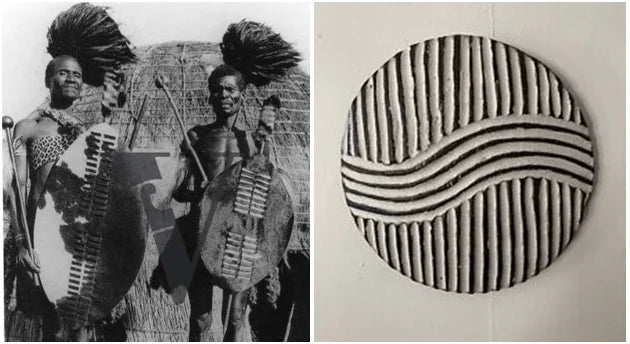A native of South Africa, the Zulu tribe belongs to the Bantu ethnic group. Shaka Zulu, a renowned warrior and ruler who reigned from 1816 to 1828, established the tribe, which rose to prominence for its military ability and territorial expansion. Throughout Southern Africa, the Zulu army’s strategies were feared. With an estimated 12 million people, they are the largest ethnic group in South Africa as of right now. They also have a rich cultural past that includes their traditional attire, music, dance, and cuisine.

Isikhethele – A Tale Of Stripes
The Amabutho was a special form of social organization used by the Zulu people. Based on their social standing and age, this system classified men into groups and gave them corresponding tasks and duties within the community. The highest position in this system belonged to warriors, who were revered. Isikhethele stripes, which marked the warriors’ path, were embroidered on their armor and carved into their shields. The Zulu tribe has a wide variety of additional ideas regarding the symbolism of stripes. Others thought the stripes were a strategy to terrify foes and make the warriors stand out on the battlefield, while some said they symbolized the warriors’ valor and might in combat. Some people also think that the stripes have spiritual significance and are linked to the ancestors’ spirits.


Zulu clothes and shields often include a combination of black, white, and occasionally red stripes. The most prevalent stripes are black and white, which are positioned either diagonally or horizontally. Depending on the design and the desired meaning, the precise amount of stripes and their placement can change. A ceremonial dress or an article of daily wear could have a different pattern than a warrior’s shield. The placement and repetition of the stripes might also serve as a clue as to the warrior’s rank or the importance of the situation. The highest ranking warriors frequently wear shields with two black stripes on a white backdrop, which are said to offer spiritual protection. Young warrior initiation rituals frequently involve a shield with many black and white stripes arranged in a zigzag or checkerboard pattern. Zulu warriors occasionally add additional patterns or symbols to their clothes and shields, including geometric shapes or animal themes. These extra components could potentially have further unique cultural or spiritual significance.
Zulu By VLiving
VLiving takes inspiration from the dynamic culture of the Zulu tribe. The iconic Isikhethele stripes are at the heart of this collection whereas the usage of an earthy and natural color scheme, like the off-white and beige tones in this assortment of home furnishings pay homage to the group’s strong connection to nature and the environment. It reflects the colors of the terrain and gives off feelings of coziness, warmth, and rootedness while creating a sense of harmony by bringing the outside into the home. The collection also exhibits the dramatic and detailed tribal design while putting the Zulu-inspired stripes front and center.


A textured and layered look is created through the use of tufted off-white stripes on beige slub cotton fabric, adding depth and intricacy to the design. The cushion covers come in a range of sizes, making them easy to mix and combine to create a distinctive and customized look.
The couch throws are generously proportioned to provide both flair and comfort by elegantly draping over the back of your preferred couch or armchair. The entire collection is produced with the best components and skilled craftsmanship, guaranteeing that it will survive for many years.
In today’s globalized society where people are exposed to a wide variety of cultures and aesthetics, integrating foreign design aspects such as Zulu tribal elements into home decor can make for a more diverse and eclectic living space. Such visual inspirations in the home not only add a sense of adventure and transport you away from the routine of daily life, but are truly the epitome of having a global home, serving as a means to promote and honor the rich legacy of indigenous cultures.

